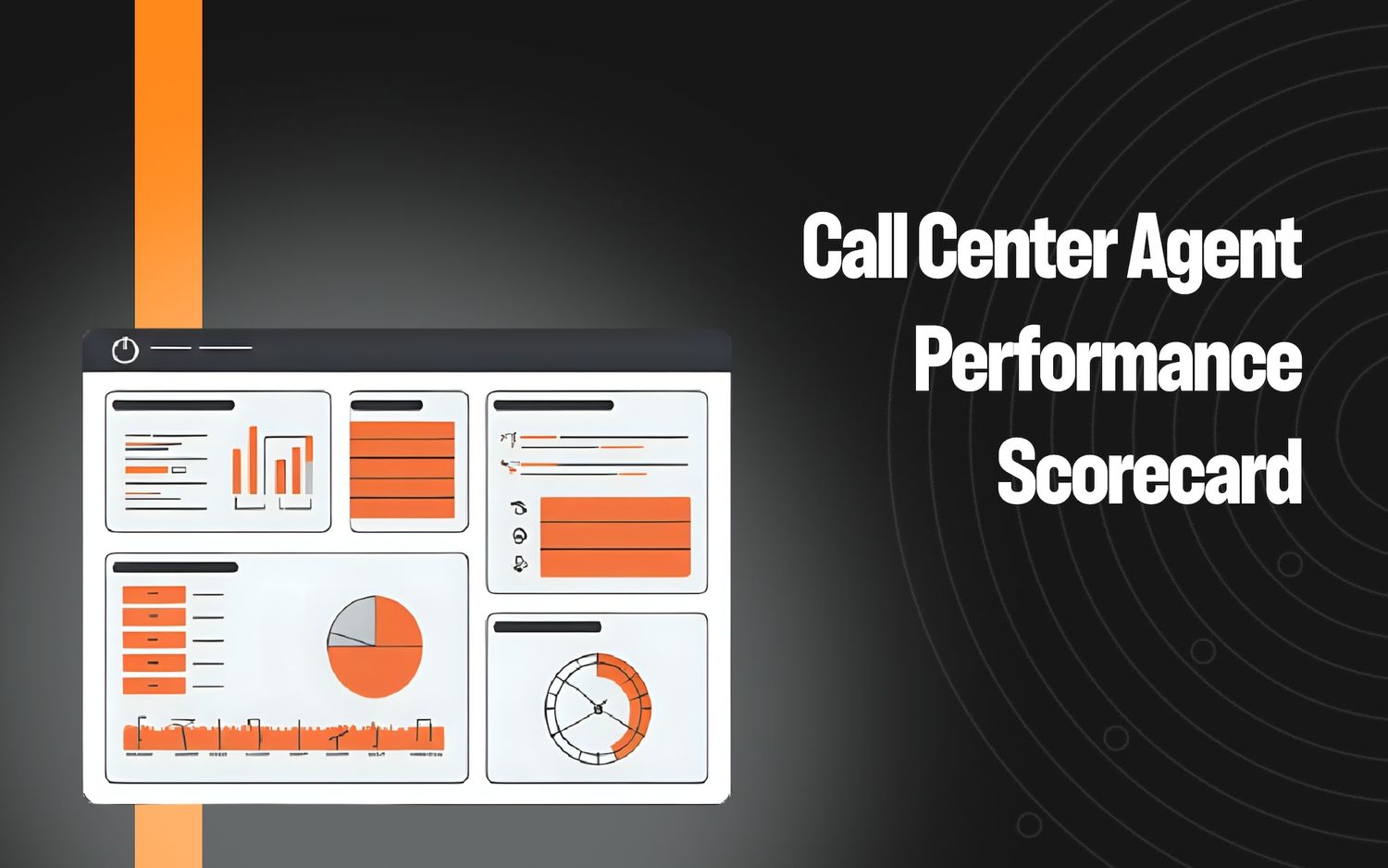An In-Depth Guide to Call Center Sentiment Analysis

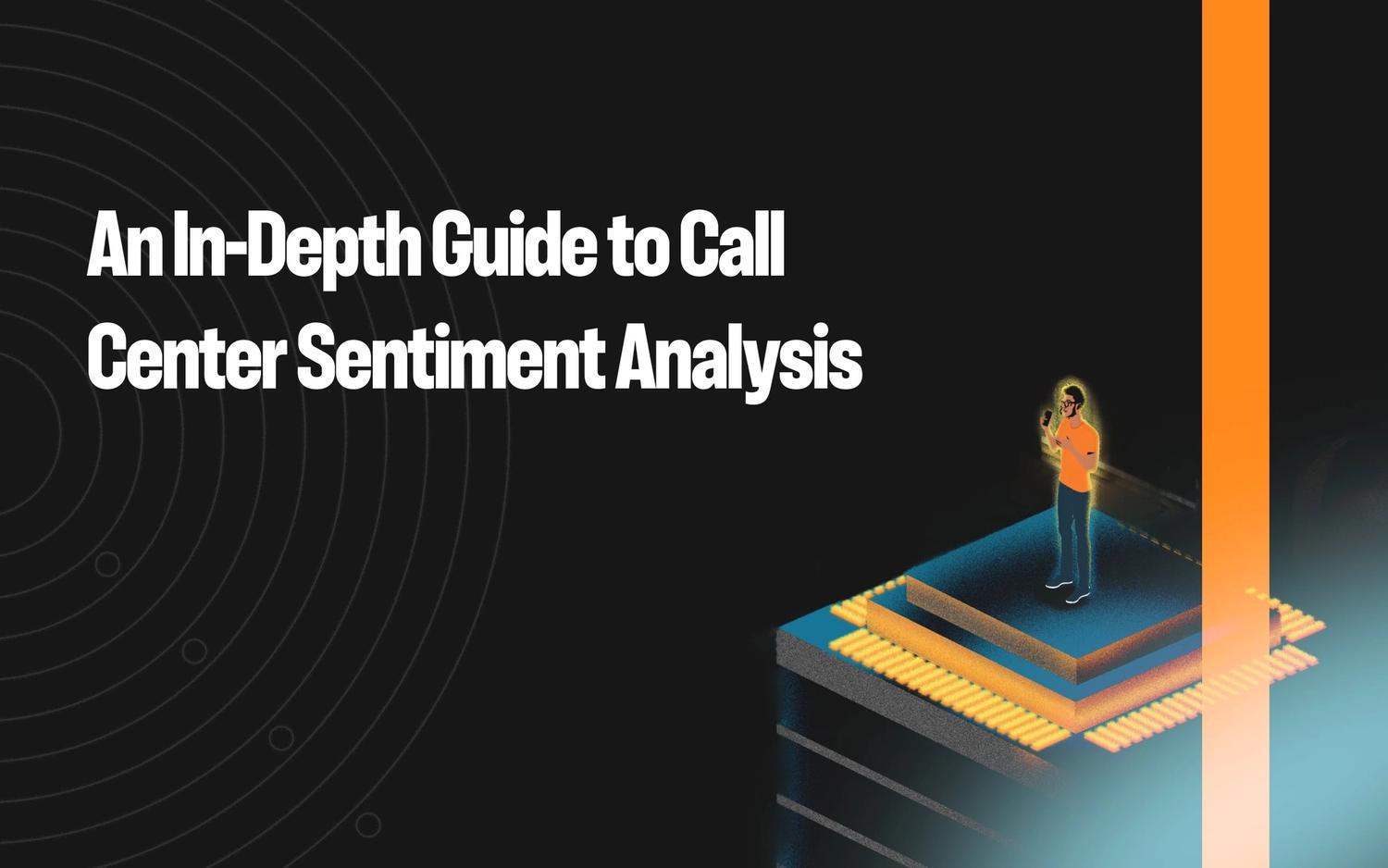
Call center sentiment analysis software enables you to:
- Detect and understand customer emotions during interactions with your support team, so you can intervene when necessary.
- Identify recurring emotional patterns to address areas for improvement in your customer service operations.
- Replace customer surveys with automated Voice of the Customer (VoC) insights by analyzing tone, intensity, and topics of customer feedback.
- Improve targeted coaching and agent training by providing actionable insights that highlight specific areas where agents can improve their communication and service skills.
In this guide, we explain sentiment analysis in detail, discuss how to choose the best software, and provide examples of how Level AI — our sentiment analysis software with secure and customizable generative AI capabilities — helps call centers improve agent performance and customer experience.
What is Call Center Sentiment Analysis?
Sentiment analysis is the process of determining the opinions and emotions (e.g., positive, negative) expressed by customers during calls.
Traditionally, this was done through post-call customer surveys and subjectively by agents, who might have noted any feelings expressed by the customer after the call.
While some companies still rely on surveys and agents' impressions, this manual approach has downsides:
- Only a small percentage of customers respond to survey requests, leaving you with incomplete data.
- Of the customers who do respond, most have either a really positive or negative experience, skewing the data.
- Agents often don’t have time to write detailed notes, leading to overgeneralizations or inaccurate reporting based on their mood or impressions.
Most modern call centers use sentiment analysis software to address these issues. However, the accuracy of that software influences how effectively they’re able to identify sentiments and categorize customer calls.
In the next section, we’ll discuss the pros and cons of the two main types of sentiment analysis software.
Two Types of Sentiment Analysis: Rule Based vs AI Powered
Most contact center sentiment analysis can be categorized into one of two buckets: rule-based or AI powered. Below, we’ll explain these categories and highlight the reasons why an AI powered system should be your preferred choice.
Rule-Based Sentiment Analysis Software
Sentiment analysis based on rules relies on predefined patterns, phrases, and criteria like the frequency of certain words to classify emotions.
For example, some software might categorize calls where the customer uses words like “unhappy” or “don’t like” as clear signs of negative sentiment. But this approach has limitations and relies on binary classification (positive or negative), failing to capture the full spectrum of human emotions such as disappointment, anger, or excitement.
Additionally, it uses keyword matching to detect emotions, which isn’t the best way to detect what a customer is feeling.
Natural language understanding (NLU), combined with generative AI, unlocks conversational intelligence, offering more accurate ways to interpret what customers really mean when they use certain words.
AI-Powered Sentiment Analysis Software
AI, combined with advanced NLU and semantic intelligence, understands the meaning and context behind what's being said, enabling it to detect a wide range of emotions and provide deeper insights into customer interactions.
It generally offers higher accuracy due to better contextual understanding and can interpret complex linguistic features like sarcasm, which are often missed by keyword-based systems.
For example, if a customer were to say, "Fantastic! My order was delivered three days late. Just in time for the party I wasn't able to have!" an artificial intelligence system would understand the context and sarcasm, detecting that the customer is actually disappointed.
In contrast, a rule-based system might only catch positive keywords and assign a positive score to such negative sentiment.
The ability to accurately detect what customers are feeling and experiencing helps organizations quickly identify and address subtle signs of dissatisfaction before they escalate, helping to improve retention and churn rates.
Use Cases and Key Features of Level AI in Call Centers
In this section, we’ll cover the use cases for sentiment analysis, how AI-powered sentiment analysis works, and the features that support these use cases, using Level AI as an example.
Assess a Conversation's Overall Sentiment
Contact centers relying solely on traditional metrics and KPIs like CSAT, especially those derived from surveys, may get a skewed view of satisfaction, as responses tend to come mainly from customers who are either very satisfied or very dissatisfied.
This leaves out more neutral or moderate experiences that provide a fuller picture of overall service quality, and misses sentiments essential for truly understanding and improving the customer experience.
For example, a customer may rate their experience as "satisfied,” but that score won’t capture underlying emotions such as frustration over a delay, concern about a future issue, or disappointment over unmet expectations. These emotions can influence their overall perception, but a typical CSAT score doesn’t reveal them.
For this reason, Level AI goes beyond simple categorizations to detect a broader range of emotions than any other product on the market:
- Anger
- Disapproval
- Disappointment
- Worry
- Happiness
- Admiration
- Gratitude
Our platform also uses sentiment-classifying algorithms to assign an overall Sentiment Score on a scale of 0 to 10, with 0 being strongly negative and 10 being strongly positive.

Scoring includes all sentiments expressed during an interaction but applies a weighted approach to different parts of the conversation.
For example, our system places more weight on end-of-call sentiments than those expressed earlier, as they tend to more accurately reflect the customer's feelings about the resolution provided.
A customer who starts a call unhappy but ends happy indicates that the agent effectively solved their problem.

The system's ability to detect and analyze a wider spectrum of emotions helps quality assurance and customer support teams understand the sentiments of the often-overlooked "middle" customer group — those who are neither extremely satisfied nor extremely dissatisfied.
When analyzing sentiment, it’s important to focus not only on post-call QA but also on live interactions. The ability to discern changes in customer sentiment during a call provides managers with opportunities to guide agents in real-time and correct situations that are heading in the wrong direction.
For instance, Level AI’s Real-Time Manager Assist displays a Sentiment Score for all calls in progress, allowing you to instantly see how customers are feeling:
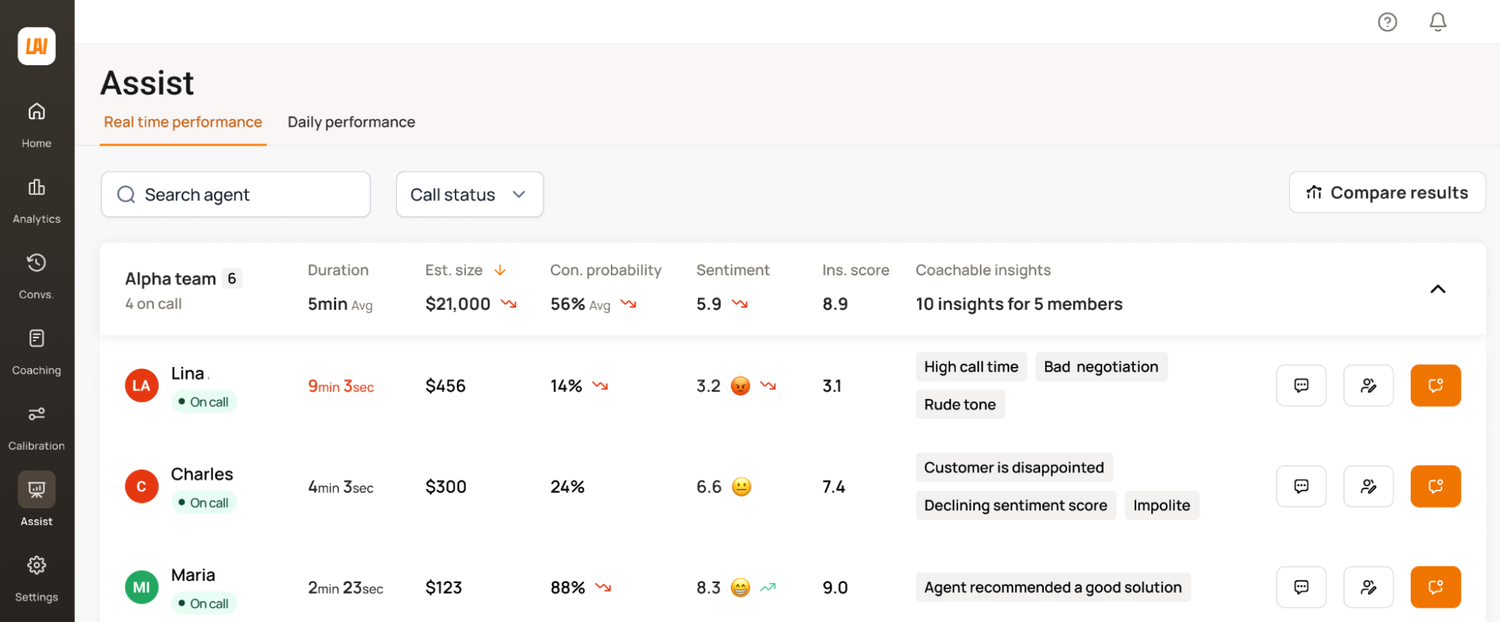
Real-Time Manager Assist provides functionality like Call Whisper and Barge in case intervention is needed during a call.
Identify Coachable Moments
Traditionally, call centers randomly select 1–2% of call recordings for quality review. QA analysts listen through these recordings to identify teachable moments, such as when an agent makes a mistake or doesn't handle a call well.
While this small sample size is meant to be representative, from the agent’s perspective, being called out for a one-time mistake can feel frustrating. Additionally, focusing on just one or two calls may not capture recurring agent habits or behavior patterns that need correction.
This is why Level AI analyzes all conversations, not just a few, to:
- Identify recurring issues that might go unnoticed with random call sampling.
- Ensure fairness by evaluating complete performance rather than isolated instances.
This comprehensive coverage provides a better picture of how agents are performing, rather than relying on duration or random selection to pick calls.
With this approach, you can be confident that your coaching efforts are focused on the right conversations.
Our dashboards give an overview of all conversations, along with indicators highlighting phone calls worth further review:

One way to investigate how a call went is by reviewing its sentiment tags, which appear throughout the conversation and reflect the emotions expressed by both agents and customers.
These tags highlight moments where significant emotional shifts occurred during the call, such as when a customer moved from disappointment to satisfaction.

Sentiment tags are highly useful not only because they guide you to specific areas of interest, but also because you can apply them in Level AI’s reporting module to answer questions like:
- Which agents successfully handle negative interactions with customers?
- What patterns of agent behavior are associated with shifts from neutral or positive to negative sentiment?
- Which agents consistently receive positive sentiment but fail to resolve customer issues?
- How do sentiment scores vary across different customer types or issues for individual agents?
You can also build reports based on other data, such as Sentiment Score, grouping conversations into ranges from lower to higher.
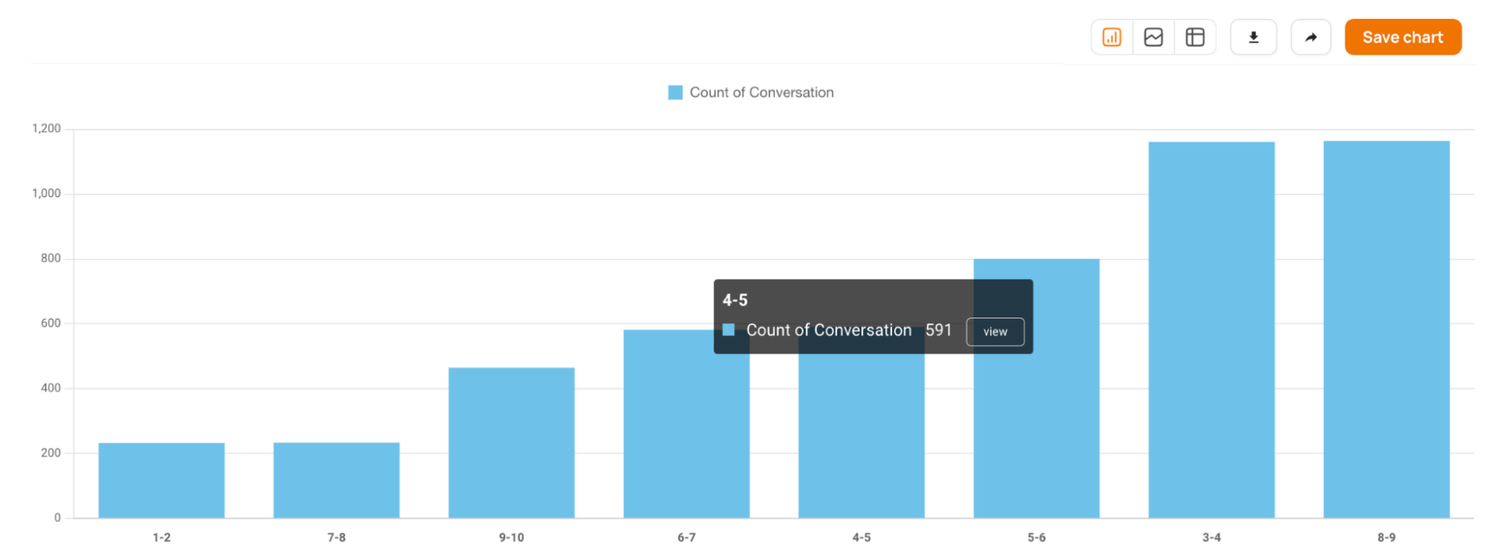
You can use other Level AI features in conjunction with sentiment results to identify coachable moments.
InstaScore shows you how well an agent performed in a conversation against predefined rubrics such as:
- Did the agent use the customer's name when appropriate?
- Did the agent acknowledge the customer's problem or request to show understanding?
- Did the agent offer a relevant solution or resolve the issue effectively?
- Did the agent follow company procedures and guidelines when providing solutions?
InstaScore is shown next to Sentiment Score on the All Interactions dashboard, and is expressed as a percentage of how well the agent did the corresponding rubric.
This gives managers and QA analysts an at-a-glance reading of agent performance, allowing them to decide whether to follow up with reviewing the conversation or not.
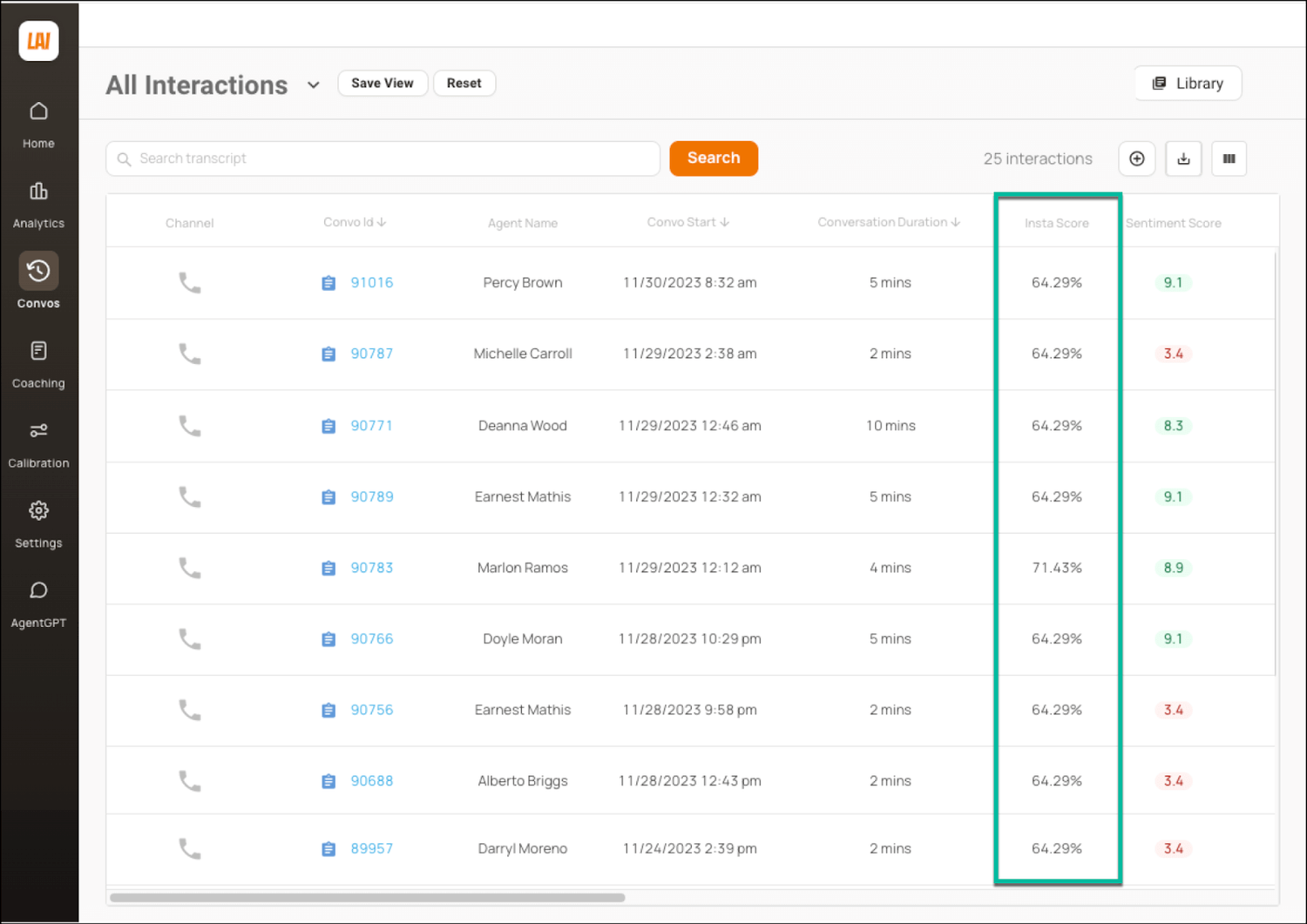
Level AI’s InstaReview automatically tags conversations for further scrutiny based on criteria like:
- High number of requested assists
- Longer than average duration
- Low customer satisfaction
This feature helps coaches and call center managers quickly identify conversations that require further investigation.
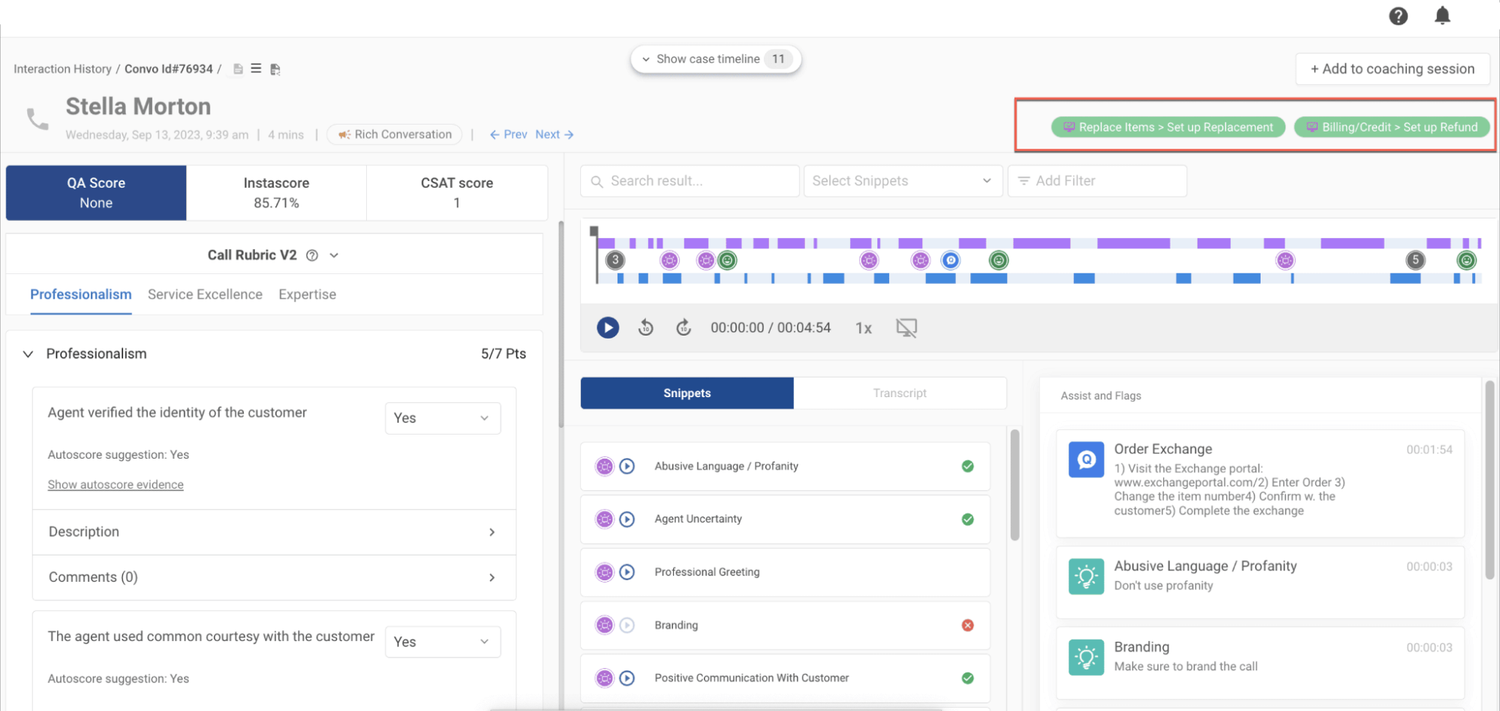
Level AI administrators can also share these dashboards with call center agents, enabling self-learning and allowing agents to track their progress over time.
Uncover Subtle Customer Sentiment Trends
As highlighted earlier, traditional methods of collecting Voice of the Customer (VoC) trends, such as sending surveys, often suffer from low response rates and biases.
This makes it difficult to get an accurate picture of customer needs, feelings about your brand, and broader customer interaction patterns.
Instead of relying on surveys for post-interaction data, Level AI automatically collects, aggregates, and analyzes data directly from customer interactions.
This includes not only typical VoC metrics like CSAT, FCR, and NPS, but also significant patterns the software uncovers regarding how customers perceive your brand and any challenges they might be facing.
For example:
- Frequent mentions of difficulty using a specific feature or navigating the product.
- Consistent negative customer sentiment following the implementation of a new policy, such as a price increase or changes in service terms.
- Numerous mentions of misunderstandings or complaints about the billing process, discounts, or pricing structures.
- An increasing number of customers expressing interest in resolving issues independently through self-service options, such as knowledge bases or automated chatbots.
Level AI’s VoC insights are presented in intuitive dashboards allowing you to quickly discern emerging trends and customer satisfaction scores:
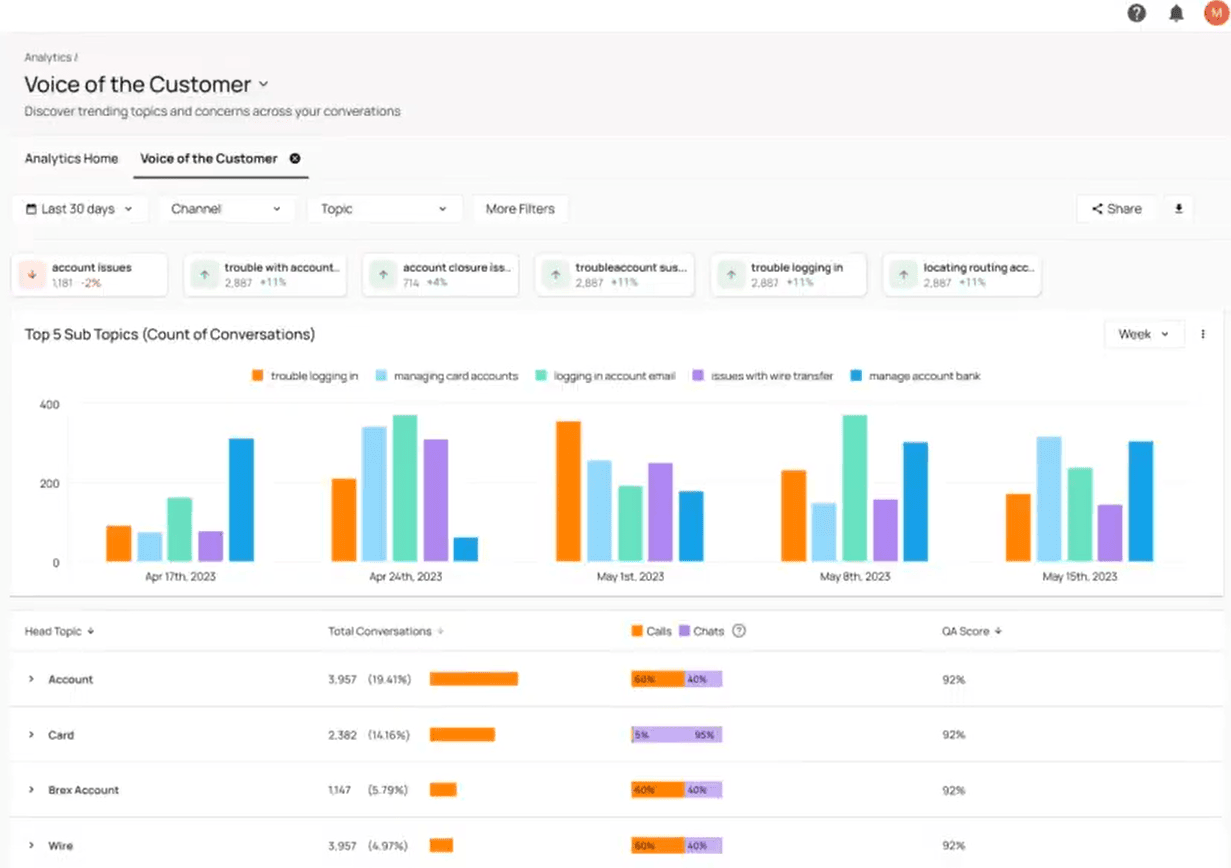
You can dive deeper into the data to uncover root causes or see aggregated trends over a specific time period.
One example is the “Top 5 Topics” dashboard, which provides a real-time view of your organization's most frequently occurring customer pain points.
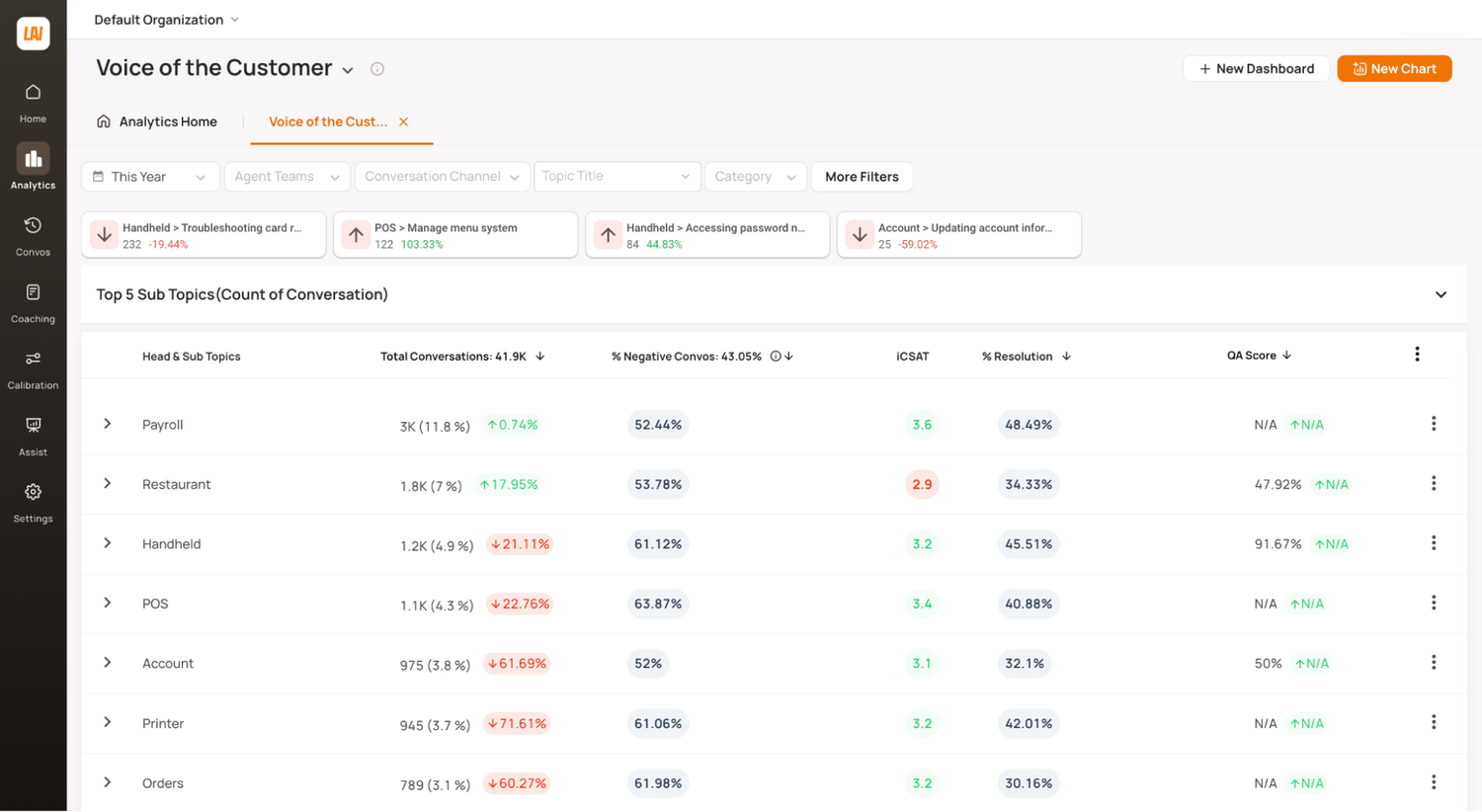
Users can toggle the time period to view topics by day, week, or month, or filter by complaint categories such as account transactions and credit cards.
Additionally, you can view negative customer conversations as a percentage, identify the channels where these conversations are occurring, and analyze the topics being discussed.
Improve Customer Satisfaction with Call Center Sentiment Analysis Tools
Level AI accurately gauges the overall sentiment of your customers, giving contact center managers the tools needed to quickly analyze and act on opportunities. This allows contact centers to scale their QA efforts at the same cost, achieving results previously unattainable with older technologies.
Interested in implementing call center sentiment analysis into your daily operations? Book a call with Level AI today to learn how we can improve your customer satisfaction scores and agent performance.
Keep reading
View all

